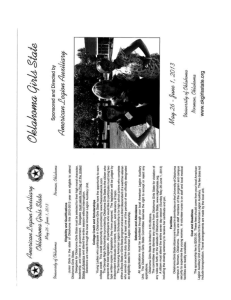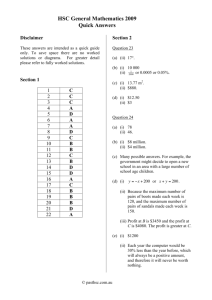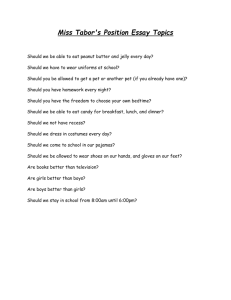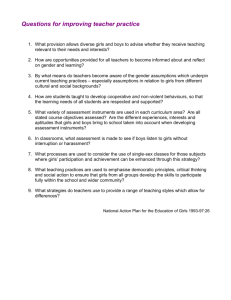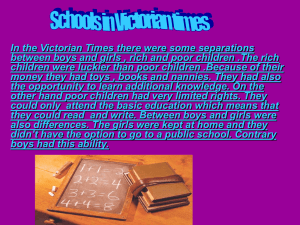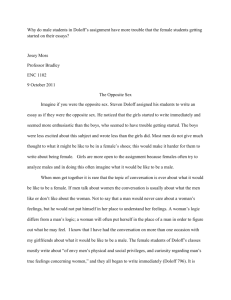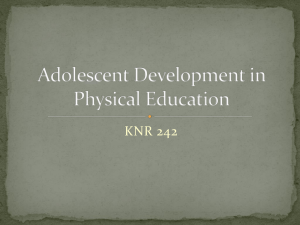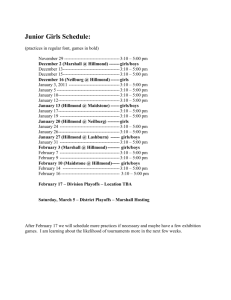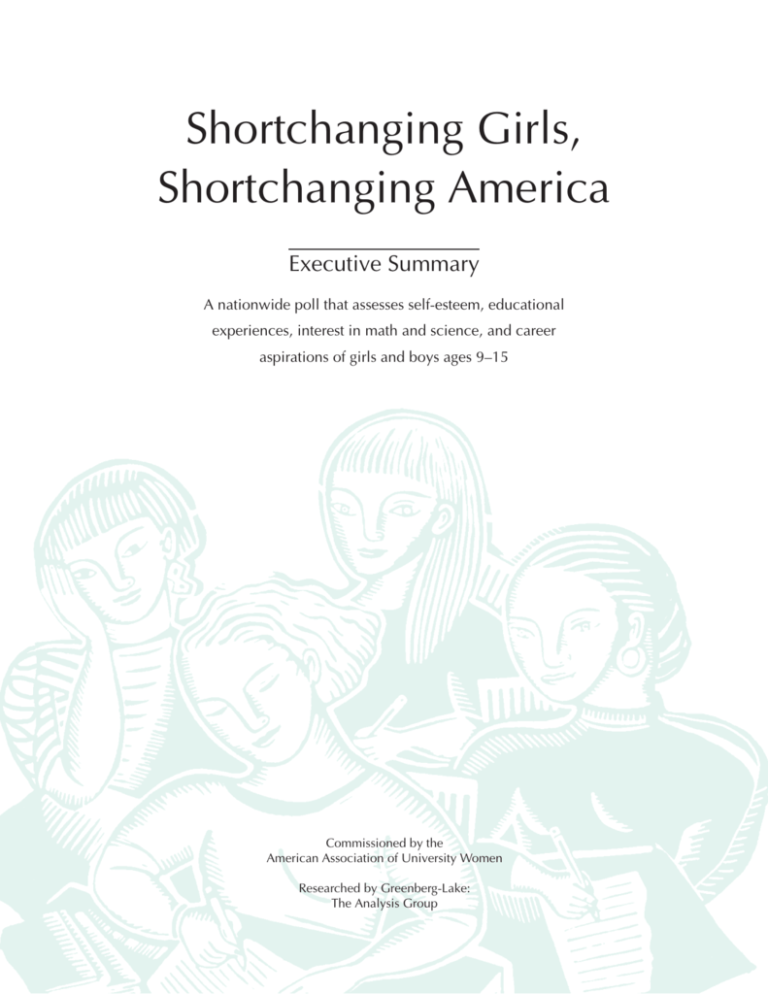
Shortchanging Girls,
Shortchanging America
Executive Summary
A nationwide poll that assesses self-esteem, educational
experiences, interest in math and science, and career
aspirations of girls and boys ages 9–15
Commissioned by the
American Association of University Women
Researched by Greenberg-Lake:
The Analysis Group
Project advisers:
For their invaluable work on this project, we thank:
Carol Gilligan, Harvard University; author, In a Different Voice; co-author, Meeting at the Crossroads:
Women’s Psychology and Girls’ Development
Nancy Goldberger, psychology faculty, the Fielding Institute; co-author, Women’s Ways of Knowing: The
Development of Self, Voice and Mind
Janie Victoria Ward, assistant professor of education and human services, Simmons College
Shortchanging Girls,
Shortchanging America
Executive Summary
A nationwide poll that assesses self-esteem, educational
experiences, interest in math and science, and career
aspirations of girls and boys ages 9–15
Commissioned by the
American Association of University Women
Researched by Greenberg-Lake:
The Analysis Group
Published by the
American Association of University Women
1111 Sixteenth Street N.W.
Washington, DC 20036-4873
202/785-7700
Copyright © 1991, 1994
American Association of University Women
All rights reserved
Printed in the United States
First Printing: January 1991 (20,500 copies)
Second Printing: August 1994 (10,000 copies)
Cover art by Thorina Rose
Library of Congress Cataloging-in-Publication Data
Shortchanging Girls, Shortchanging America: executive summary: a nationwide poll that assesses self-esteem,
educational experiences, interest in math and science, and career aspirations of girls and boys ages 9–15/
commissioned by the American Association of University Women; researched by Greenberg-Lake: the Analysis Group.
2nd ed.
p. cm.
ISBN 1-879922-02-9: $8.95
1. Sex discrimination in education—United States. 2. Self-esteem in women—United States. 3. Self-esteem in
children—United States. 4. Women in mathematics—United States. 5. Women in science—United States.
6. Women—Education—United States. 7. Vocational interests—United States. 8. Educational equalization—United
States. 9. Educational surveys—United States.
I. American Association of University Women. II. Greenberg-Lake: the Analysis Group.
LC212.82.S56 1994
370.19’345--dc20
94-27744
CIP
T ABLE OF C ONTENTS
The Poll’s Significance ................................................ 4
Executive Summary .............................................. 6–13
The Scope of the Survey .................................... 6
Survey Summary ................................................ 7
Afterword: Effecting Change .................................... 14
3
EXECUTIVE
SUMMARY
T HE P OLL ’ S S IGNIFICANCE
his is a summary of the poll that awakened the nation to the effects of gender bias in America’s schools. Commissioned by the American Association
of University Women and conducted by Greenberg-Lake: The Analysis
Group, Shortchanging Girls, Shortchanging America was the first national survey to
link the sharp drop in self-esteem suffered by pre-adolescent and adolescent American girls to what they learn in the classroom. Publication of the poll in 1991 shook
America’s consciousness and has had a far-reaching impact.
Thanks to the poll and such subsequent studies as the AAUW Educational
Foundation’s The AAUW Report: How Schools Shortchange Girls, which synthesized
more than 1,300 published studies on girls in school, equity for girls has earned
a firm place on the nation’s education reform agenda. Educators and community
leaders have discussed the problem of gender bias in open forums and are now
working in communities across the nation to change the future for girls in school.
Outstanding teachers have received fellowships from the AAUW Educational
Foundation’s Eleanor Roosevelt Fund to explore new teaching methods that bolster girls’ self-confidence and enhance their learning. And in 1994 the U.S. Senate heard testimony on proposed legislation to promote equal education for girls
in America’s public schools.
By 1994 concern sparked by the poll and later research helped spawn a heightened sensitivity to the needs of girls. The Ms. Foundation credits AAUW, Carol
Gilligan, and others for helping to inspire its national “Take Our Daughters to Work”
Day. Peggy Orenstein’s powerful book Schoolgirls, excerpted in the New York Times
Magazine and Glamour magazine, grew directly out of the AAUW poll. Gender equity provisions written into “Goals 2000: Educate America,” the federal education reform act passed in 1994, likewise were influenced by AAUW’s seminal
research.
The new awareness comes not a minute too soon. For the 23 million schoolgirls in grades K–12 of our nation’s classrooms, change is clearly overdue. In an
increasingly technological society, we can no longer afford to let our schools sideline
girls and discourage their achievement.
For what happens to girls in school is cause for grave concern. Girls begin
first grade with comparable skills and ambition to boys, but by the time girls fin-
T
4
SHORTCHANGING
GIRLS,
SHORTCHANGING
AMERICA
ish high school, most have suffered a disproportionate loss of confidence in their
academic abilities.
Popular culture helps deflate girls’ self-esteem by marginalizing women and
stereotyping their roles. Unintentionally, schools collude in the process by systematically cheating girls of classroom attention, by stressing competitive—rather
than cooperative—learning, by presenting texts and lessons devoid of women as
role models, and by reinforcing negative stereotypes about girls’ abilities. Unconsciously, teachers and school counselors also dampen girls’ aspirations, particularly in math and science.
Is it any wonder that many girls consequently become women who aim lower
and achieve less than they should? Our entire society loses the contributions they
might have made if only they’d been encouraged to expand their horizons. We
also jeopardize girls’ ability to grow into responsible citizens and parents with the
skills to challenge and nurture their own children.
Changing this pattern is not just a matter of fairness but one of economic
urgency. By the year 2005, women will make up 48 percent of the nation’s work
force. If we continue to compromise the education of half our work force, America
will lose its competitive edge. The equation is that simple.
Girls’ low self-esteem and consequently lower aspirations are problems that
schools can—and must—help solve. And if we are to meet the pressing need for
an increasingly skilled work force, we must solve the problem now. For more than
a century, the American Association of University Women has worked to promote
equity and education for women and girls. Today, through the energy and commitment of its 150,000 members nationwide, AAUW is working with teachers,
principals, parents, and community organizations to eliminate gender bias in the
classroom.
The effort began early in 1990, when AAUW commissioned an extensive examination of the comparative self-esteem levels, career aspirations, educational
experiences, and math/science interests of American girls and boys. That fall the
Greenberg-Lake research firm interviewed nearly 3,000 girls and boys ages 9 to
15 of varied racial and ethnic backgrounds to explore the impact of gender on
their self-confidence, academic interests, and career goals. Those findings are presented in summary here.
5
EXECUTIVE
SUMMARY
T HE S COPE OF THE S URVEY
he national self-esteem poll Shortchanging Girls, Shortchanging America,
conducted for AAUW by Greenberg-Lake, quantifies some of the critical
changes in self-perception that school experiences bring to adolescents. The
survey examines the differences between girls’ and boys’ perceptions of themselves
and their futures, and identifies critical processes at work in forming adolescents’
self-esteem and identity. It then looks at the development of adolescents’ aspirations
and the part schools play in forming adolescents’ career choices and expectations
and their perceptions of gender roles. And finally, the survey examines the
relationship of math and science skills to the self-esteem and career goals of the
girls and boys who will make up the next century’s work force.
This executive summary presents the chief survey conclusions in a highly condensed and easily accessible form. Accordingly, it often uses single dramatic responses to illustrate findings that are based on analyses of patterns across many
measures. For a more complex picture and in-depth analysis, readers should consult
the full 500-page survey, containing all survey questions and responses and crosstabulations from multiple indicators, verified by the entire research team. For information, call 202/785-7761. The price for members is $60, for nonmembers $85.
Adolescence, the period of transition from childhood to adulthood, is a critical time for the development of self-identity. Dramatic changes in biology and
psychology coincide with the need to make a broad set of choices and decisions.
And the interpretations of gender differences that girls and boys make at this stage
have a profound impact on the adult lives of women and men in our society.
Shortchanging Girls, Shortchanging America surveyed roughly 3,000 children—
2,374 girls and 600 boys—between grades 4 and 10 in 12 locations nationwide.
The survey was conducted from Sept. 19 through Nov. 14, 1990. The sample for
this study was stratified by region. Greenberg-Lake developed clusters of states
and took a random selection sample across each strata and cluster proportionate
to the number of school-age children in each state the previous year. Researchers
analyzed survey results by gender and race—looking at responses for white girls
and boys, black girls and boys, and Hispanic girls and boys—but, following standard research practice, did not report on subgroups where error was too high
because of small subsample size. Topics of research and the survey language were
refined in a preliminary series of focus groups.
In all, children were asked to respond to 92 questions touching on their attitudes to school, self-esteem, view of gender roles, classroom experiences, and career
aspirations. Complex self-esteem measures were based on responses to a battery
of 26 questions grouped into six broad categories: individual or personal self-esteem, family importance, academic confidence, isolation, voice, and social acceptance. All findings are based on multiple indicators and conclusions drawn by
multiple independent analysts.
T
6
SHORTCHANGING
GIRLS,
SHORTCHANGING
AMERICA
S URVEY S UMMARY
much less confidence about themselves and
As girls and boys grow older, both experience
their abilities. Sixty percent of elementary
a significant loss of self-esteem in a variety of
school girls say they are “happy the way I
areas. However, the loss is most dramatic and
am,” a core measure of personal self-esteem.
has the most long-lasting effect for girls. The
More boys, 67 percent of those surveyed,
summary presents key findings about self-esalso strongly agreed with the statement.
teem levels in adolescents, about the effects of
Over the next eight years,
young people’s declining sense of
I’
M
H
APPPY
THE
W
AY
I
A
M
girls’ self-esteem falls 31 perself on their actions and abilities,
P E R C E N T “ A LWAY S T R U E ”
centage points, with only 29
and about institutional influences
100%
percent of high school girls
on adolescents’ lives. These find90%
Girls Boys
describing the statement “I’m
ings represent the beginning of an
80%
67%
happy the way I am” as always
understanding of the complex
70%
60%
56%
60%
true. Almost half of the high
relationship between adolescent
46%
50%
school boys (46 percent) retain
self-image and careers, the differ37%
40%
their high self-esteem. Thus
ences in that relationship due to
29%
30%
the gender gap has grown from
gender, and the impact of math
20%
7 points to 17 points.
and science on self-esteem and
10%
career aspirations.
0%
Elementary
Middle
High School
Graph A shows girls and
Graph A
boys experiencing a loss of
A gender gap in self-esteem
self-esteem as they grow
increases with age.
older, with adolescent girls
S
E
L
F
E
S
T
E
E
M
I
N
D
E
X
showing a dramatically
The adolescent years, marked
7
greater loss. The sharpest
by dramatic changes and condrops in self-esteem occur in
6
tradictions, strongly affect the
Girls Boys
the years between elementary
self-esteem of both girls and
4.99
5
4.68
4.65
school and middle school.
boys. However, the survey finds
3.93
4
dramatic differences in levels
2.80
2.77
The drop in self-esteem
and trends in esteem between
3
during the adolescent years
girls and boys, with more boys
2
and the accelerating and widthan girls entering adolescence
1
ening gap in self-esteem bewith high self-esteem and many
tween girls and boys is most
more young men than young
0
Elementary
Middle
High School
clearly presented by calculatwomen leaving adolescence with
Graph B
ing a “Self-Esteem Index”
high self-esteem.
from the five tested measures of basic individual self-esteem: “I like the way I look,”
Girls aged eight and nine are confident,
“I like most things about myself,” “I’m
assertive, and feel authoritative about themhappy the way I am,” “Sometimes I don’t
selves. Yet most emerge from adolescence
like myself that much,” and “I wish I were
with a poor self-image, constrained views of
somebody else.” See Graph B.
their future and their place in society, and
7
EXECUTIVE
SUMMARY
Declining self-esteem, a governor on
dreams and future actions, more
strongly affects girls than it does
boys.
The overall declines in self-esteem during adolescence have their greatest impact on girls as self-esteem turns to
action. The survey finds that adolescent
girls are more likely than boys to have
their declining sense of themselves inhibit their actions and abilities. This difference between girls and boys grows
more pronounced with age.
The biggest difference in self-esteem
between girls and boys centers on the
subject of “doing things.” Boys are much
more likely than are girls to feel “pretty
good at a lot of things.” Almost half the
boys say this statement is always true,
compared to less than a third of the girls.
Boys’ sense of confidence in their ability to “do things” correlates strongly with
general self-confidence.
Adolescent girls
are more likely
than boys to
have their
esteem among boys is apparent in their
greater confidence in their own talents, a
point of intersection between feeling and
action. Almost twice as many boys as girls
refer to their talents as what they like most
about themselves. Boys’ confidence in
their ability in sports—four times as high
for adolescent boys as for girls—is the
source of much of the difference.
declining sense
of themselves
inhibit their
actions and
abilities. This
difference
Physical appearance, fundamental to
the self-esteem of all young people, is
much more important to the self-image
of girls than of boys. Girls are nearly
twice as likely as boys to mention a
physical characteristic as the thing they
like most about themselves. Physical appearance is most important for girls in
middle school, the time of greatest decline in self-esteem.
grows more
As girls and boys go through adolescence, both experience traumatic physipronounced
cal changes, and their perceptions of
those changes are central to patterns of
with age.
self-esteem. However, the way girls and
boys see those changes and the degree to
Boys also report a greater willingness
which those changes influence self-image
to speak out. Boys are more likely than are
differ sharply by gender. Boys tend to view
girls to “speak up in class a lot” and, as
the physical changes positively, as getting
Graph C shows, to “argue with my teachbigger and stronger. Girls beers when I think I’m right.”
lieve their changes lead in a
I A RGUE W ITH M Y T EACHERS
W HEN I THINK I’ M R IGHT
negative direction, reinforcAs adolescent girls and
P ERCENT “ A LWAYS T RUE”
ing their declining self-esboys get older, their confi50%
teem and gender stereotypes.
dence in their abilities reflects
Further, boys’ greater confia growing gender gap. As
40%
Girls Boys
dence in their talents and
Graph D shows, the 10 per28%
30%
their ability to do things
centage point difference becushions their uneasiness
tween elementary school girls
20%
about changes in their apand boys becomes a 19-point
15%
pearance; in contrast, society
difference between high
10%
tells girls more strongly that
school girls and boys.
their worth is dependent on
0%
Graph C
their appearance.
The greater sense of self-
8
SHORTCHANGING
GIRLS,
SHORTCHANGING
AMERICA
Finally, self-esteem is
Hispanic girls are much
I’ M G OOD AT A L OT OF T HINGS
critically related to young
less confident and positive
P E R C E N T “ A LWAY S T R U E ”
people’s dreams and sucthan black girls and go
80%
cesses. The higher self-esteem
through a crisis in some ways
70%
Girls Boys
of adolescent boys translates
even more profound than
60%
55%
into bigger career dreams.
that of white girls. While His50%
46%
45%
Boys start out at a higher level
panic girls start with signifi42%
40%
than do girls when it comes
cantly higher levels of
29%
30%
to their career aspirations.
self-esteem than white girls,
23%
20%
The number of boys who astheir confidence plummets in
pire to glamorous occupatheir appearance, family rela10%
tions (rock star, sports star) is
tionships, school ability, tal0%
Elementary
Middle
High School
greater than that of girls at events, and importance.
Graph D
ery stage of adolescence, creBetween elementary school
ating a kind of “glamour gap.”
and high school, their perFurther, boys are slightly more likely than
sonal self-esteem drops 38 points, more
are girls to believe their own career dreams
than the drop for any other group of girls.
will come true.
Family and school, not peers, have the
greatest impact on adolescents’ selfesteem and aspirations.
Finding it difficult to dream and feeling constrained by gender rules, girls start
out with lower hopes for their careers, and
are already less confident in their talents
and abilities. Girls are much more likely
than boys to say they are “not smart
enough” or “not good enough” for their
dream careers.
Popular literature suggests that peers dominate the world of teenagers. In fact, the
survey finds that several other factors, especially adults and the adult institutions of
family and school, have a greater impact on
adolescents’ self-esteem and aspirations.
There are important interactions between race and trends in self-esteem. Black
A factor analysis probe of self-esteem
girls express high levels of self-esteem from
shows that a feeling of acceptance by peers
elementary school through high school.
ranks well below academic confidence and
While family and community reinforcement
a feeling of importance within the family as
sustain high levels of personal importance
a dimension of adolescent self-image.*
for black girls,
these girls feel
*Factor analysis is a
Girls’ Self-Esteem by Race and Grade
strong pressure
statistical technique
“Happy the Way I Am”
that looks at the
from the school
Percent Always True
underlying dimensystem and experisions in attitudes
Elem. Middle H.S. Change
All
ence a significant
across a number of
White Girls
55
29
22
-33
34
drop in positive
questions, and at the
Black
Girls
65
59
58
-7
60
relationships and
feelings about their
relative importance of
Hispanic Girls
68
54
30
-38
52
teachers and their
those dimensions.
schoolwork.
9
EXECUTIVE
SUMMARY
Pride in schoolwork and a feeling of
being good at things decline rapidly during
adolescence. In elementary school, about
half of the students always feel “proud of the
work I do.” By high school, only one in six
students still feels that way.
Although the overall
structure of self-esteem is
similar for girls and boys,
small differences provide important insights. For boys,
the sense of confidence in
their ability to do things correlates more strongly with
general self-esteem than with
other aspects of academic
confidence. As they discover
that people believe males can
do things, adolescent boys
gain self-esteem. According
to the focus groups, girls find
that people, including their
teachers, believe girls cannot
do the things girls think they
can. The result for girls is
lower self-esteem.
For girls, feelings about
academic performance correlate strongly with relationships with teachers. Teachers
are important role models for
girls. Nearly three out of four
elementary school girls and
more than half of high school
girls want to be teachers. Far
fewer adolescent boys, at any
to be teachers.
100%
90%
80%
81%
70%
60%
50%
40%
For elementary school girls, in fact, academic self-esteem is the most important
aspect of self-esteem; yet, it is for them already a negative force. Fewer than half the
girls in elementary school (49 percent) say
they feel pride in their schoolwork, and that
percentage drops 32 points to 17 percent
in high school. (The percentage of boys who are proud of
L I K E M A TH
BY GRADE AND GENDER
their schoolwork also drops
between elementary and high
Girls Boys
84%
school, from 53 percent to 16
percent—but academic pride
72%
68% 70%
61%
plays a much smaller role in
the structure of boys’ self-esteem.)
30%
20%
10%
0%
Elementary
Middle
High School
How students come to
regard math and science
differs by gender.
Graph E
One of the most dramatic
and easily measured effects of
LIKE SCIENCE
schools and teachers on their
BY GRADE AND GENDER
adolescent students is in the
100%
teaching of mathematics and
90%
Girls
Boys
82%
science. The survey finds a
80%
76%
75%
75%
strong relationship between
70%
70%
63%
perceived math and science
60%
skills and adolescent self-es50%
teem. Of all the study’s indi40%
30%
cators, girls’ perceptions of
20%
their ability in math and sci10%
ence had the strongest rela0%
tionship to their self-esteem;
Elementary
Middle
High School
Graph F
as girls “learn” that they are
not good at these subjects,
grade, want
their sense of self-worth and aspirations for
themselves deteriorate.
Thus, teachers have a special opportunity to affect the self-esteem of their female
students, and, by instilling confidence, to
shape their interests and aspirations.
As Graphs E and F show, an overwhelming majority of young people like
math and science. Most elementary school
students also have confidence in their abil-
1 0
SHORTCHANGING
GIRLS,
SHORTCHANGING
AMERICA
ity to do math, though levels are higher for
boys than for girls. All students’ enthusiasm
for math and science is greatest in the elementary years and drops precipitously as
they get older. Graph E shows the most dramatic losses are among girls.
81 percent of elementary
school girls like math. By
high school, 61 percent
say they like math.
helps erode their enjoyment of math. Adolescent boys, at all grade levels, are much
more confident than young girls about their
abilities in math. Half of all elementary
school boys, but only one-third of all elementary school girls, say they are good at
math. By high school, one in four males, but
only one in seven females,
still says that he or she is
G I R L S A N D M AT H
L I K E M AT H V S . G O O D AT M AT H
good at math.
100%
90%
84 percent of elementary
school boys like math. By
high school this percentage drops too, but less
than it does for girls, to
72 percent.
80%
Like Math
81%
Good at Math
68%
70%
61%
60%
50%
40%
31%
30%
18%
20%
15%
10%
Pluralities of elementary
school girls (24 percent)
and boys (32 percent)
name math as their favorite subject. By high
school, these percentages
decline to 12 percent and
23 percent.
0%
Elementary
Middle
High School
Graph G
B O Y S A N D M AT H
L I K E M AT H V S . G O O D AT M AT H
100%
90%
84%
Like Math
Good at Math
80%
72%
70%
70%
60%
Conversely, the percent49%
50%
age of girls who name
40%
math as their least favor30%
ite subject jumps from 15
20%
percent in elementary
10%
school to 28 percent in
0%
Elementary
high school. The percentage of boys who like math
least jumps from 9 percent to 21
percent.
31%
25%
Middle
High School
Graph H
Adolescent girls and
boys interpret their problems
with math differently. Large
percentages of both girls
and boys who dislike math
do so because they get bad
grades or consider it too
hard. As girls get older, the
percentage who dislike math
because it is “too hard” drops
and the percentage who dislike math because they get
“bad grades” increases. As the
boys get older, they come to
believe that they do not like
math because the subject itself is “not useful.” Girls interpret their problems with
math as personal failures.
Boys project difficulty more
as a problem with the subject
matter itself.
Interest in science shows
similar patterns.
The number of girls who like science
drops from 75 percent in elementary
school to 63 percent in high school.
Although overwhelming numbers of
adolescents “like” math, significantly fewer
believe they are “good at math.” As Graphs
G and H show, adolescents’ confidence in
their ability declines as they get older and
In elementary school 82 percent of boys
like science; 75 percent of boys still like
science in high school.
1 1
EXECUTIVE
SUMMARY
While most students who dislike
math do so because they consider it “too
hard,” most students who dislike science
say science is “not interesting.” However,
as girls grow older, we see a similar pattern to that we saw with math. Adolescent girls are more likely than adolescent
boys to find science uninteresting. Adolescent boys are more likely than girls to
discount the importance of science itself.
circular
relationship
between
enjoyment of
math and
science and
There is a circular relationship
between liking math and science,
enjoying self-esteem, and
identifying career interests.
self-esteem.
Students who
like math and
science possess
The school system provides the most important place to make a positive impact
on the self-esteem of adolescents, as well
as on their career preferences. The relationships between math and science,
self-esteem, and career preferences provide an important example of the kind
of difference schools can make. Because
of the differences in the ways adolescent
girls and boys think about math and science, the influence of teachers on young
women and their self-esteem and careers
is particularly strong.
Adolescents who say they
like math and science are
more likely to prefer careers in
occupations that they believe
make use of these subjects. By
small margins, students who
like math and science express
stronger desires for careers as
teachers, doctors, and scientists.
Even more important,
students who like math and
science are more likely to as-
pire to careers as professionals. On an
open-ended measure of career preference
(“What do you really want to be when
you grow up?”), students who like math
and science are more likely to name professional occupations as their first career
choice. The impact is stronger for girls
than for boys.
There is a
significantly
greater
self-esteem;
students with
Enjoyment of math and science is
also related to career choice in a more indirect way. As Graph I shows, there is a
circular relationship between enjoyment
of these subjects and self-esteem. Students who like math and science possess
significantly greater self-esteem; students
with higher self-esteem like math and
science more. These students like themselves more, feel better about their
schoolwork and grades, consider themselves more important, and feel better
about their family relationships.
higher self-
The differences by gender are important. Dramatically, adolescent girls who
esteem like
like math are more confident about their
math and
appearance than are all adolescent boys,
whether or not they like math (and than
science more.
adolescent girls who do not like math).
And girls who like math and
science worry less about othM ATH /S CIENCE AND S ELF- E STEEM
ers liking them.
P ERCENT “H APPY THE W AY I A M”
80%
70%
Like
Don’t Like
60%
50%
40%
48%
48%
35%
35%
30%
20%
10%
0%
Math
Science
Graph I
This greater sense of selfconfidence has a measurable
effect on confidence about career choices for both girls and
boys. Girls and boys who like
math hold onto their career
dreams more stubbornly and
are less likely to believe they
will “probably end up being
something different from what
you sometimes want to be.”
1 2
SHORTCHANGING
GIRLS,
SHORTCHANGING
AMERICA
Finally, all adolescents see large differences between the sexes, and these differences increase the tensions and
contradictions for girls as they get older.
Gender stereotypes are still a major force
in shaping the career expectations of
young people. Girls are much more likely
than boys to want to be homemakers
(+32 percent), teachers (+33 percent),
and nurses (+35 percent). Adolescent
boys are much more likely to want to be
sports stars (+42 percent), construction
workers (+18 percent), and scientists
(+21 percent). The work force in the year
2000 will require many more scientists,
engineers, and mathematicians. However, by high school, while 52 percent of
boys think they would enjoy being scientists, only 29 percent of girls share that
opinion.
The work force
in the year
2000 will
require many
more scientists,
engineers, and
mathematicians.
However, by
high school,
Still, the survey also reflects the dramatic societal changes in the last two decades. Most young people assume that
women will combine a job outside the
home with their job inside the home.
Even more girls than boys think they
could enter certain professions, most noticeably, the law.
These changes in gender perception
are among the brightest findings of the
survey, and signal a broad potential for
even greater changes with a better understanding of the reciprocal relationships
between schools and female students.
These results present a critical challenge
to schools as we face the social and economic realities of the next century.
while 52
percent of boys
think they
would enjoy
being scientists,
only 29 percent
of girls share
that opinion.
1 3
EXECUTIVE
SUMMARY
–Greenberg-Lake:
The Analysis Group
A FTERWORD : E FFECTING C HANGE
Never before has there been so much concern with improving American schools. And
never before has there been so pressing a
need for change to meet the educational
needs of American girls, as well as boys.
As we prepare for a new century in
which women will account for almost half
of our work force, we must face facts: For
America to have a first-class work force
tomorrow, we must provide a first-class
education for girls today. For U.S. students to rank first in the world in mathematics and science by the year 2000, we
must reverse the notion that “girls aren’t
good at math and science.”
Schools must play a role in changing the messages girls receive within their
classroom walls. Despite popular beliefs
that peer groups and peer pressure dominate the actions, values, and goals of
teenagers, Shortchanging Girls, Shortchanging America shows that school and
family have a greater impact on adolescents, especially girls.
by Myra and David Sadker, professors of
education at American University, reveals:
Teachers typically initiate more communication with boys than with girls in
the classroom, strengthening boys’
sense of importance.
For U.S.
students to
rank first in
the world in
mathematics
and science by
the year 2000,
we must
How Schools Set Girls Up to Fail
reverse the
Schools transmit gender bias in the thousand and one signals they send girls and
boys about what’s expected of them.
These expectations determine how girls
and boys are treated, how they’re taught,
and ultimately how they’re tracked onto
different paths through their schooling
and into their careers. In dozens of separate studies, researchers have found that
girls receive less attention, less praise, less
effective feedback, and less detailed instruction from teachers than do boys. Research
notion that
“girls aren’t
good at math
Teachers tend to ask boys more complex, abstract, and open-ended questions, providing better opportunities for
active learning.
In class projects and assignments,
teachers are more likely to give detailed
instructions to boys, and more likely to
take over and finish the task for girls,
depriving them of active learning.
Teachers tend to praise boys more often than girls for the intellectual content and quality of their work. They
praise girls more often for neatness and
form.
When boys perform poorly, teachers
often blame failure on lack of effort.
Girls receive a different message; the
implication is that effort would not
improve their results.
All too often, teachers and counselors
track girls away from courses of study
that lead to high-skilled, high-paying,
high-technology careers.
and science.”
The barrage of negative messages hits
girls at an especially vulnerable stage in
their lives. As Shortchanging Girls, Shortchanging America shows, many of the same
negative signals impact girls across racial
1 4
SHORTCHANGING
GIRLS,
SHORTCHANGING
AMERICA
and ethnic lines, though to somewhat varying degrees. New AAUW research will explore these variations further.
AAUW believes
Of additional concern is how well
prevalent teaching methods satisfy the
individual learning styles of girls and
boys. Some children, including many
girls, learn better in cooperative settings.
Competitive learning, favored in most
classrooms, is a style that often puts girls
at a disadvantage.
principal at the Burncoat Middle School in
Worcester, Mass., uses flash cards with students’ names on them. “I shuffle the cards
and call the names randomly. It drives
the kids crazy. They never know when
their name is coming.” Neither does she.
that teachers
Promoting Community Involvement
are
Parents, activists, and community leaders have gotten in the act, too. Following the suggestions of AAUW, parents are
contacting the Title IX coordinators in
their school districts to assess Title IX
compliance in local schools. (Title IX of
the 1972 Education Amendments is the
federal law that prohibits sex discrimination in federally funded educational
institutions.) Parents are also working
with teachers and students to draft
sexual harassment policies in schools.
spearheading
an effort to
Reinventing the Classroom
bring needed
AAUW believes that teachers are spearheading an effort to bring needed change
to the classroom. Increasingly, committed teachers are scrutinizing their teaching styles and classroom behaviors for
the hidden messages they convey. The
concept has gained so much credence
that training on gender issues has been
incorporated into some professional development courses for teachers.
change to the
classroom.
Increasingly,
committed
Through coalitions with local businesses and community groups, parents
and activists are exploring new programs
to enhance girls’ self-esteem. Collaborations with colleges and universities have
also been productive. An AAUW brochure, “10 Tips to Build Gender-Fair
Schools,” describes other courses of action to effect change. (To request a free
copy, call 800/326-AAUW, ext. 120.)
teachers are
scrutinizing
Through its Eleanor Roosevelt Fund
Teacher Fellowships, the AAUW Educational Foundation promotes the professional development of teachers in public
school grades K–12. Each year selected
fellows study ways to improve the teaching of math and science to girls in their
classrooms. Fellows convene at an annual Teachers Institute to exchange ideas
and experiences. Back in their home
schools, they implement new teaching
strategies and share them with their colleagues.
their teaching
styles and
classroom
behaviors for
the hidden
messages they
Some of these strategies are enjoying
ever-wider circulation. To assure fairness
in calling on students, former Teacher Fellow Alice Bowen, now an acting assistant
convey.
Parents, activists, and community
groups who want to promote hands-on
science, math, and technology activities
for girls now have access to some excellent resources, such as the “Operation
SMART” activity and planning guides
published by Girls Incorporated in New
York City. Projects in the book are designed specifically to interest girls ages
10 to 14, with text and photos reflecting
that focus.
1 5
EXECUTIVE
SUMMARY
Civic and educational leaders from
Philadelphia to Los Angeles will be able to
draw from models of school gender-equity projects, funded by the AAUW Educational Foundation through a grant
from the W.K. Kellogg Foundation. Community-based projects in the “Girls Can!”
program reflect a variety of educational
approaches, cultures, races, and
ethnicities.
For information about the “Girls
Can!” program or a list of the participating communities, call 202/785-7713. A
short video about ways to correct gender bias in schools will be available in fall
1994 through AAUW. (For information
on ordering, see page 18.)
AAUW has worked in coalition with
groups like the National Education Association, the National School Boards Association, and the American Association
of Colleges for Teacher Education to
develop programs to promote change.
These groups and others now incorporate gender equity goals in their own
internal priorities.
Girls in Mathematics and Science
Nowhere are the links between expectation
and accomplishment clearer than in how
girls and boys relate to mathematics and
science. The AAUW survey found a crucial—and circular—relationship between
self-esteem levels, interest in mathematics
and science, and career aspirations:
Girls and boys who like mathematics
and science have higher levels of selfesteem. And girls and boys with
higher levels of self-esteem like math
and science.
Girls and boys who like math and science are more likely to aspire to careers
in which these subjects are essential.
AAUW has
worked in
coalition with
groups like the
National
Education
Association, the
National School
Boards
Association,
and the
American
Association of
Colleges for
Teacher
Education to
develop
programs to
promote
change.
Girls and boys who like math and science are more likely to aspire to careers
as professionals. This relationship is
even stronger for girls than for boys.
Girls who like math are more confident
about their appearance and worry less
about others liking them.
Girls and boys who like math and science hold onto their career dreams
more stubbornly. They are less likely to
believe that they will be something different from what they want to be.
Many more girls than boys lose interest in mathematics and science after elementary school.
Here again, progress is being made.
AAUW community action grants have
funded a number of math/science summer camps for girls. Chris Short, project
director of a camp for eighth- through
10th-grade girls organized by the Lassen
County, California, Branch of AAUW,
says, “The young women walked away
with strengthened self-esteem…They indicated on the camp evaluations that ‘I
am okay,’ and ‘I can do anything I want.’”
Similarly, teacher fellowships sponsored by the AAUW Educational
Foundation’s Eleanor Roosevelt Fund focus on developing new ways to draw
girls into math and science. Former
Teacher Fellow Betsy Adams, who
teaches math at Jordan High School in
Long Beach, California, sees these methods work. “Many girls begin my class with
1 6
SHORTCHANGING
GIRLS,
SHORTCHANGING
AMERICA
a negative attitude about math,” she says.
“By year’s end, they believe they too can
be math whizzes.”
“Many girls
that girls suffer greater effects than boys.
AAUW has also commissioned several
new studies to identify educational strategies that work for girls.
begin my class
Policy recommendations in The
AAUW Report: How Schools Shortchange
Girls address other actions needed by
educational, business, and political leaders to encourage the participation of girls
in math and science.
with a negative
attitude about
math,” says
A Call to Action
former Teacher
It’s time to commit ourselves to a school
system and a society that encourage girls
to attain their full potential. We in
AAUW are doing our part.
Fellow Betsy
Adams, who
teaches math at
By speaking out and commissioning
credible research, we have led the fight
for gender equity in our nation’s schools.
Our Educational Foundation published
the first comprehensive study of research
in the field: The AAUW Report: How
Schools Shortchange Girls. The Report,
which synthesized more than 1,300 published studies, documents the unequal
treatment of girls in our nation’s schools.
We have convened roundtables with
community, state, and national leaders to
address gender equity needs. We have
played a key role in the drafting of gender equity legislation now before Congress. We have provided leadership to
the diverse community projects nationwide that are trying to provide encouragement to girls. And the Foundation’s
Eleanor Roosevelt Fund for Women and
Girls has also awarded an average of 22
Teacher Fellowships a year for female
K–12 public school teachers who are
committed to finding better teaching
methods to motivate girls.
Jordan High
School in Long
Beach,␣
California. “By
year’s end, they
When Report data showed a higher
than expected level of complaints about
sexual harassment, the Foundation commissioned Louis Harris and Associates to
conduct a new study. Hostile Hallways:
The AAUW Survey on Sexual Harassment
in America’s Schools showed that four out
of five students have experienced some
form of sexual harassment in school, and
believe they
too can be math
whizzes.”
But we cannot do it alone. Our work
has been a catalyst for the changes that
are needed in our educational system and
in every other institution that influences
the aspirations and achievements of our
girls and young women.
The challenge is clear for all of us—
parents and educators as well as leaders
in business, government, and the media.
Now is the time to think, speak out, and
take action to help American girls be the
best they can be. For when we shortchange girls, we shortchange America.
–July 1994
1 7
EXECUTIVE
SUMMARY
R ESOURCES : T HE AAUW E QUITY L IBRARY
Ground-breaking Works on Gender Bias in Education
Schoolgirls: Young Women, Self-Esteem, and the
Confidence Gap (Doubleday, 1994)
Riveting book by journalist Peggy Orenstein in association with
AAUW shows how girls in two racially and economically
diverse California schools suffer the painful plunge in selfesteem documented in Shortchanging Girls, Shortchanging
America. 384 pages. $18.95 AAUW members/$21.95 nonmembers.
Shortchanging Girls, Shortchanging America
Highly readable executive summary of the 1991 poll that awakened the nation to the problem of gender bias in America’s
schools. Poll shows graphically how classroom gender bias
hurts girls’ self-esteem, school achievement, and career
aspirations. Revised edition, with updated account of poll’s
impact and review of school, community, and government
action strategies, highlights survey results with charts and
graphs. 20 pages/1994. $8.95 AAUW members/$11.95 nonmembers.
Hostile Hallways: The AAUW Survey on Sexual Harassment
in America’s Schools
The first national study of sexual harassment in school, based
on the experiences of 1,632 students in grades 8 through 11.
Gender and ethnic/racial (African American, Hispanic, and
white) data breakdowns included. Commissioned by the
AAUW Educational Foundation and conducted by Louis Harris and Associates. 28 pages/1993. $8.95 AAUW members/
$11.95 nonmembers.
Full Data Report: Shortchanging Girls, Shortchanging
America
Complete data on AAUW’s 1991 national poll on girls and␣ selfesteem, with survey questions and responses, and banners␣ displaying cross-tabulations. Includes floppy disk with all␣ data.
500 pages/1991. $60 AAUW members/$85 nonmembers.
To order, call 202/785-7761.
The AAUW Report: How Schools Shortchange Girls
Disturbing report documents girls’ second-class treatment
in America’s schools, grades K–12. The research report, commissioned by the AAUW Educational Foundation and prepared by the Wellesley College Center for Research on Women,
includes policy recommendations and strategies for change.
128 pages/1992. $14.95 AAUW members/$16.95 nonmembers.
Video: Shortchanging Girls, Shortchanging America
A dramatic look at the inequities girls face in school. Features
education experts and public policy leaders, AAUW poll results, as well as the compelling voices and faces of American
girls. VHS format/15 minutes/1991. $19.95 AAUW members/
$24.95 nonmembers.
Video: Girls Can! New Release: Fall 1994
Profiles programs around the country that are making a difference in fighting gender bias in schools. VHS format. $19.95
AAUW members/$24.95 nonmembers.
The AAUW Report Executive Summary
Overview of The AAUW Report research, with recommendations for educators and policymakers. 8 pages/1992. $6.95
AAUW members/$8.95 nonmembers.
AAUW Issue Briefs
Package of five briefs, with strategies for change: Equitable
Treatment of Girls and Boys in the Classroom; Restructuring
Education; Stalled Agenda—Gender Equity and the Training
of Educators; College Admission Tests: Opportunities or Roadblocks?; Creating a Gender-Fair Multicultural Curriculum.
1990-93. $7.95 AAUW members/$9.95 nonmembers.
The AAUW Report Action Guide
Strategies for combating gender bias in school, based on The
AAUW Report recommendations. 8 pages/1992. $6.95 AAUW
members/$8.95 nonmembers.
Action Alert
AAUW’s monthly newsletter monitoring congressional action
on educational equity as well as reproductive choice, sexual
harassment, and other vital issues. One-year subscription: $20
AAUW members/$25 nonmembers.
Help Make a Difference for Today’s Girls…and Tomorrow’s Leaders
Become part of the American Association of University
Women, representing 150,000 college graduates, and help
promote education and equity for women and girls. You can
add your voice as a Member-at-Large or work on critical
issues in one of AAUW’s 1,750 local branches. For further
membership information, write: AAUW Membership,
Dept. T, 1111 Sixteenth Street N.W., Washington, DC
20036-4873.
The AAUW Educational␣ Foundation, a not-for-profit
501(c)(3) organization, provides funds to advance education, research, and self-development for women, and to
foster equity and positive societal change. Your dollars
support research, community action projects, fellowships for
women, and teachers. Send contributions to: AAUW
Educational Foundation, Dept. 294, 1111 Sixteenth Street
N.W., Washington, DC 20036-4873.
1 8
SHORTCHANGING
GIRLS,
SHORTCHANGING
AMERICA
AAUW R ESOURCES O RDER F ORM
Name _________________________________________________________________________________________
Address _______________________________________________________________________________________
City/State/Zip __________________________________________________________________________________
Daytime phone _________________________
AAUW membership # (if applicable) _____________________
Item
Circle Price
Member/Nonmember
Schoolgirls
Hostile Hallways
The AAUW Report
AAUW Report Summary
AAUW Report Action Guide
Action Alert
Shortchanging Girls: Summary
Shortchanging Girls: Video
Girls Can!: Video
AAUW Issue Briefs 5-Pack
$18.95/$21.95
$8.95/$11.95
$14.95/$16.95
$6.95/$8.95
$6.95/$8.95
$20/$25 per year
$8.95/$11.95
$19.95/$24.95
$19.95/$24.95
$7.95/$9.95
AAUW Membership
$35
Quantity
_________
_________
_________
_________
_________
_________
_________
_________
_________
_________
Total
______________
______________
______________
______________
______________
______________
______________
______________
______________
______________
Subtotal:
6% sales tax
(DC, FL residents only)
______________
Shipping/Handling:
$4.00
______________
______________
_________
______________
Total Order:
______________
______________
For bulk pricing on orders of 10 or more, call 800/225-9998, ext. 294.
Please make check or money order payable to AAUW. Do not send cash.
Credit cards are accepted for orders of $10 or more.
■ MasterCard
■ Visa
Card #__ __ __ __ - __ __ __ __ - __ __ __ __ - __ __ __ __ Expiration __________
Name on card ________________________________ Cardholder signature _____________________________
SATISFACTION GUARANTEED: If you are not completely satisfied with your purchase, please return it within
90 days for exchange, credit, or refund. Videos are returnable only if defective, and for replacement only.
■ Please send me information on joining an AAUW branch in my area (dues vary by branch).
■ I’d like to join as a Member-at-Large. Enclosed is $35. (Fill in education information below.)
College/University
State/Campus
Year/Degree
FOR MAIL ORDERS, SEND THIS FORM TO:
AAUW Sales Office
Dept. 294
P.O. Box 251
Annapolis Junction, MD 20701-0251
FOR TELEPHONE ORDERS, CALL:
800/225-9998, ext. 294
CODE: D95ROS
1 9
EXECUTIVE
SUMMARY
1111 Sixteenth St. N.W.
Washington, DC 20036
www.aauw.org

